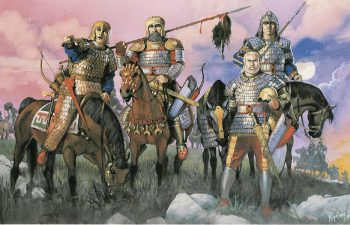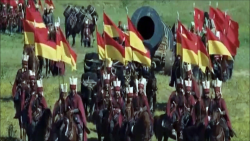History of Elwynn
A History of the Elwynnese Union from the earliest times up until the year 1623 (Elw Calendar) and the beginning of the current era. Written 'in-sim' and from a secular perspective, accounting for religious beliefs and interpretations where known or advised of. Hyperborean events are mostly excluded except where they impact upon the mainland. Similarly the overseas realms incorporated into the Elwynnese Union are only to be addressed when of relevance during the independence era.
History
Antiquity
In mythology Utas, the Treesian God of Light, was believed to have brought the deity known as Elwynn to this area, which since ancient times is considered the primary source of the River Elwynn. Tradition attributed to him also the construction a tower at a spot of the banks of the aforesaid Great River of Benacia to protect the Goddess from the attentions of her twin brother Lest. The Tower of Araxion, named after its site is noted for its prehistoric foundations and as such can be considered one of the earliest stone structures on the continent.
There is some belief amongst Antiquarians and Ethnographers that the legends that have grown up around the Tower are a reflection of the role Araxion played in the prehistoric development of the proto-Elw 'Culture Groups'. It was from this ancestral homeland that the Elw, first as hunter-gatherers and then as pastoralists, would eventually expand outwards to dominate the north of Benacia, and in so doing give rise to the myriad tribes and warbands that would cause the early Shirerithian Kaisers such consternation that they were obliged to site their Imperial Capital at Shirekeep in order to defend and ultimately - at the expense of much blood and treasure - pacify the region.
Cimmerians, from the islands of Cimmeria on the north-eastern shore of Benacia, attacked Elwynn with increasing frequency and held various points along the northern coast. This went back and forth for a while until Cimmeria was granted county status as part of Hyperborea.
Mediaeval Period
1356: Kaiser Raynor I unites Brookshire and Goldshire, invades Elwynn. In the Battle of Shirekeep, he occupies the Elwynn fork. Elw tribes bravely battle on.
1443: Imperial Republic of Shireroth founded with Erik II as kaiser.
1454: Duchy of Elwynn established, initially known as Northshire and not extending far beyond a fortified pale (area enclosed by a palisade) around Shirekeep.
1469: Hyperborea annexed to Elwynn as barony.
1478: Eros Darkstar appointed Bard of Elwynn. Hyperborea under Kalir Sethan reaffirms its allegiance to Elwynn and Duchess Mari Greenwood.
1484: First elections held in Elwynn. Austi Scot, baron of Novi Dalmacija, builds a statue in honour of Mari Greenwood in Novi Dalmacija.
1487: Kaiser announces plan to demote Elwynn from duchy-status to barony-status and give Hyperborea duchy-status. The Duchy government completely rejects the plan. Hyperborea offers compromise. Kaiser rejects compromise and reiterates his plan. Landsraad votes to demote Elwynn. Elwynn established as barony under the Duchy of Hyperborea.
The reduction of the Elwynnese nobility during the wars of conquest, the introduction of the Elfinshi under the nos Fëanor and Greenwood dynasts during the 1470's followed by the subsequent downfall of those Elvish houses during the looming Babkhan era would play a key part in forming the ultimately egalitarian nature of the Elw majority. The destruction of the indigenous landowning and warrior castes prevented the formation of a stratified aristocracy and led to the significant noble families that arose in the subsequent eras, Kalir, Osman, Ettlingar Freyu (Hyperborean, Babkhi and Froyalanish respectively) deriving from immigrant stock.
1st Babkhan Era
1488: Mari Greenwood abdicates in favour of Ardashir. First Babkhi epic on Lest published. Great Osmanid Charter proclaimed. Greenwood and entourage emigrate to Delvenus. Order of the Dead Stag established. Capital punishment reinstated, Hyperborea responds by putting Ardashir under house arrest and overturning all baronial laws, then occupying all of Elwynn. Civil War ensues. The Duke Rulak of Hyperborea (Locke) then further dissolves the Order of the Dead Stag. The Babkhan Shah made a diplomatic protest on behalf of his kinsman and the Kaiser responded by saying it's a ducal matter, pledges neutrality. Considered the year of Elfinshi genocide.
1489: Cease-fire called by Ardashir. Elf molestations, kitten drownings and puppy burnings are all halted (or at least suspended for the moment). Ardashir's rule restored.
1494: Donation of Elwynn. Temples of Cedrist worship to Ryvenna and B'caw established in Elwynn. Today's Ryventemple and B'cawshrine.
1495: Halluci dragons are battered by multi-national artillery before the East Elwynn Sluices, flee into Goldshire.
1496. Diplomatic crisis with Goldshire over the White Elwynn. Baron blames Goldshire for river piracy, orders cleansing of river.
1497: Military engagements with Goldshire.
1506: Genocide reconciliation and commemorations begins in Count Lyon's tour d'Elwynn.
1508: Umra Mosque opened in Eliria. Yardistan declares war on Elwynn for lack of collective punishment against the Babkhi community for the Elfinshi genocide. Baron Lyon forms militia. Halluci mass immigration to Illumination begun (along with dragons).
1509: Elwynnese borders closed to all but citizens of Elwynn, Lac Glacei, Brookshire, Amity, Mirioth, the Grand Commonwealth, Stormark, Cranda and Hallucination. County of Port Illumination established. Amir Osmani makes the Triumphant Folk speech, calls for boycott of Brookshire (under which Elwynn is a barony). Lesser Zjandaria established as Babkhi county (Ardashirshahr, Caligae and Vijayanagara Communes). Lady Vesteralen made a citizen of Elwynn (Not Shireroth) by Baron Lyon, provokes imperial government and married her. Elwynn raised to duchy, celebrations across the country, meanwhile protests in other parts of Shireroth against the foreignness of Elwynn, boycotts of Elwynnese products. Peace treaty between Yardistan and Elwynn.
1510: Duke holds discussion with nobles whether to join MSX (a flawed but briefly popular banking system), gets Imperial Smackdown (a form of direct intervention popular in the autocratic period). Count Ozarka sues and indicts Lord Bill of Antya over a sexual slur. Chief Justice Davis hears case, then leaves it for lacking merits. Cease and desist order from Kaiseress Semisa on Vasroie's activities (Matthew Basil. Co-Baron of Port Ill. Byz.).
1512-1513: Major famine
1514: Chief Justice Rob Davis dies.
1516: Andelarion appointed baron of Elwynn.
1526: Andelarion inherits the throne of the Kingdom of Babkha as "Rashid Shahanshah".
The Babkhan era saw a marked socio-economic change in Elwynnese society. In the attitudes of the period the emphasis was on sins originating from economic motives, characterised by the depiction of Mari Greenwood and her retainers as the personifications of unearned reward. The welfare of the human community being prejudiced by the avarice and irresponsibility of the Elfinshi ruling classes. Ironically it was the arrival of Babkhan migrants, at the instigation of Hyperborean and Treesian interests, which saw the greatest upheaval, with the introduction of heavy industries such as gunpowder mills and iron works into what had previously been an agrarian and rural idyll sustained - at least in the Froyalandish telling - by the favour of the goddess Elwynn herself and the suffused magic of the Elfinshi themselves.
In their place came a rough-hewed crew of Babkhan ghazis - holy warriors of the Zurvanist faith - merchants and engineers, all hungry for resources and land. Those who lived through the times perceived a catastrophic social and economic crisis arising from the wars of the late 1480's and the 1490's where the mortality rate approached 30% in some areas, causing a desperate shortage for the farms and the factories. In the next decade incomes for the surviving Elw peasants rose dramatically prompting socially repressive laws aiming to keep the peasantry tied to their places of work. A particularly harsh example was the Forestry Law promulgated by Baron Ardashir which can still be found within the Elwnameh body of customary law in Alalehzamin. The Forest of Elwynn itself was rapidly diminished during this period, with trees being felled for construction projects such as the damming of the West Elwynn and the construction of the East Elwynn Sluice as well as a doomed effort by Baron Ardashir to build two causeways by which an invasion of the Cimmerian Isles might have been mounted. In addition to these vainglorious projects the ever ravenous demands of industry for fuel and timber saw ever greater numbers of trees felled.
In spite of new tracts of land being opened up by deforestation to ever more intensive forms of agriculture imported from the Euran continent the export of grain back to the Kingdom of Babkha produced the desperate hunger famine of 1512-1513. The Babkhan settlers, faced by falling rent-rolls and deserted holdings, pressed their tenants harder still.
Insurrection however was, ironically enough, prevented by the efforts of Brookshire, Yardistan, Kildare and Goldshire to evict the 'foreigners' from the realm. The Elw had always considered themselves to be a people apart and when faced by their Southern neighbours, advancing as liberators, made common cause with the Babkhi and with the growing community of Stormarkers in Wintergleam who would eventually come to be regarded as the Froyalandish. This culminated during the so-called War of Vengeance when the Count of Araxion, and his battle-hardened retinue of Huskarls formed the core of the army that threw back the Antyan invasion fleet in one of the decisive engagements of the war.
This destructive period nonetheless saw the first commencement of Elwynn's struggle towards modernity that, within a century, would see an industrialised society arise from the ruins of the mediaeval world. Elwynn would cease to be a backwater and take its place at the top table of Shireroth.
The 'Froyalandish' Era
1533: Kaiser names Harald of Ettlingar Freyu duke of Elwynn. Elwynn changes name to Froyalan.
1535: Andelarion, Carol and Nathan of Natopia inducted to the House of Ettlingar Freyu (Shireroth branch). Logthing of Froyalan established and called to session. Asgard calendar made official. K'Tzuni bombs the West Elwynn Dam, Logthing contemplates war.
1536: Hesam Jahandar named Count of Hyperborea. Duke names Freyja patron goddess of Elwynn/Froyalan, the people respond by mass-demonstrations. Araxion repatriated.
2nd Babkhan Era
1542: Harald abdicates, Kaiser Hasan (Hesam) succeeds. Elwynn is restored as name of the duchy and the "Elwynnbrigaden" defence force plays a key part in the "War of Jeremy's Ear". Hasan is shot by Ardashir in Ardashirshahr, Rashid Andelarion succeeds as Kaiser Ayreon. The episodic Ayreon-Loki Civil War that will define Elwynnese public life for the next sixty years begin over the disputed succession to the Golden Mango Throne. Initially the Ayreonist faction prevails. Byzantopol, a city founded by Jahandar exiles employed by Automat Inc. emerges in Bjorngard as a self-regulating polity (robocracy), a precursor to the Raikothian system of Oracles and the modern Coordinated State. Some consider this to be rather disconcerting.
Early Modern Era
1543: Wil Nider made duke.
1544. Kaiser Ayreon commits suicide.
1546: Iskander Mirkdale named duke of Elwynn. Logthing becomes Council of Eliria.
1550: Uprising against the Duke, "White Lily Revolt"
1551: Year of the Four Dukes (Iskander Mirkdale, Jacobus, Rai Avon-El, Andrew Allot). Ayreon finally buried at Cape Farewell. People's Academy established.
1552: Alumelith massacre (Ohl'Tar)
1553: Ohl'Tar Revolt
1554: Causality War sees the use of the "Narrativity Bomb" on the Ohl'Tar infestations in Agnesia and the final extermination of that species.
1555: Duke Nathan leaves throne to Leo Fenrir. Amokolia war affects Elwynn.
1556: Ocia bombs Caligae and Civitas Nova.
1558: Leo abdicates in favour of Isabelle Allot.
1559: Isabelle Allot abdicates in favour of Cho'gall.
1560: Eliria is temporary war capital of Shireroth
1562: Duchy of Elwynn destroyed by Kaiser, house system implemented, House of Kalir founded, Daniel Kalirion (former Duke of Brookshire) named patron.
Independence
1567: Declaration of Independence of Elwynn. Daniel Kalirion named president (raes) of the Elwynnese realm.
1568: Ardashir blows the Elwynnese Congress up in protest at the slow pace of negotiations with Shireroth and also at Lord Erion's continued retention of his own limbs.
1569: Independence recognized by Shireroth in peace treaty, Shireroth reclaims East Elwynn.
1570: Lord Erion elected President.
1572: Amokolia issues its Midnight Declaration, leaves Victoria and joins Elwynn.
1573: Elwynn and Hurmu merge to become Realm of Elwynn and Hurmu. Provisional government and elections. Persecution of Butter Cow followers in East Elwynn.
1574: Daniel Kalirion elected Prince of Elwynn and Hurmu.
1584: Kolmenitzky embassy crisis. Ardashir rehabiliated by Senate.
1585: Natopia becomes Elwynnese protectorate.
1586: Daniel Kalirion is assassinated at Cape Farewell. Nathan is elected Prince.
1587: "Elwynn, Amokolia and Hurmu (Riqi Adurellion" becomes "Union of Elwynn, Amokolia and Hurmu"
1588: Daniel's son Elijah becomes Kaiser of Shireroth as Kaiser Ayreon II, married Prince Nathan of Elwynn.
1589: Kaspar Soleiman takes the Senate hostage. Prince Nathan killed.
1590: Elijah Ayreon elected Prince of Elwynn. "Union of Elwynn, Amokolia and Hurmu" becomes "Elwynnese Union"
1592: Elijah Ayreon declines re-election, Aaden Allot elected prince. Normark joins the Elwynnese Union. Raspur Pact signed.
1593: Nau is adopted by Elijah and Nathan.
1594: Aaden Allot impeached and removed, Luix Rakira ruling Steward. Air Mango incident, bombings in East Elwynn and the Absentias.
1595: Elijah Ayreon elected Prince once more.
Re-unification
1597: Albion admitted as UT. East Amokolia Act reduces Amokolian UT's territory and gives it to Elwynn proper. Elijah Ayreon declines re-election, Tarjei Einhornsson elected Prince against Jacobus Loki but Constitutional Coup backed by Shireroth sees the Usurper take power instead.
1598: Omnitree Group nationalized by Govt. Mass protests. Normark declares independence. Elijah Ayreon murdered by Sisera in Wahlstadt. Misguided messianic cults begin to proliferate.
1599: Hurmu independence from Elwynn.
1600: Treaty of Unification with Shireroth ratified, Soreaa Isurui made Secretary of the State in the provisional government. Tirlar, Albion and Amokolia made independent.
1601. New constitution enacted. Deimos Jasonides elected prince. Congressional elections.
1602: The Cabbage Plague sees the ecology of the lower reaches of the Blue and White Elwynn Rivers devastated. The Red Elwynn becomes utterly devoid of life. Owing to the high levels of accumulated toxicity, the populations of Shirekeep, the Imperial County and the County of Lesser Zjandaria rapidly succumb to an aggressive strain of the Barentsz-Melang Syndrome (Brassicosis) previously only documented in Leng and the Absentias. "Triumph of Rrakanychan" painted by an excitable Batavian artist based on lurid eye-witness accounts; southern regions of the State of Elwynn destabilised and the Quarantine enforced by General Royston Merrick necessitated increasing military interventions into the Imperial County.
The Coordinated State
1603: "Restoration of the People's Government", congressional elections follow an unsuccessful putsch staged by Merrick, the first - self-styled - Conducător.
1604: Constitutional Coup by Stewardess Soreaa Isurui. Deimos voted out , Nathaniel elected prince.
1605: Nathaniel/Soreaa deposed, Coordinated-Government instituted by second Conducător Daniel Simrani-Kalirion, Nathaniel remains nominal prince. Constitution is placed into venerated-occultation and replaced by the Charter of Coordination. The Counties are replaced by 182 Bailiwicks with authority devolved to Governors and Municipal Guild Corporations supervised by Wardens in Elwynn Proper and the Marches (Northern, Eastern and finally Western). Communism declared and the State refuses to recognise or accept transactions in fiat currency. Private wealth and ownership permitted to continue.
1606: Remaining Corporations nationalised. All private wealth confiscated and remaining money withdrawn from circulation and effectively outlawed. Black Market proliferates.
1607: Nathaniel declared dead. Daniel Simrani-Kalirion elected Prince. Purges of the Guild of Aldermen by the Court of the Prince and the Court of Star Chamber target the last remnants of the landowning feudal gentry and the formerly capital owning bourgeoisie. Replaced by elite technocratic leadership cadres chosen by merit. Charles Froughton made subject to Pastoral Care Order and dies of an unexpected heart attack. Disorder in the Bailiwick of Fieldberg.
1608: Third Congressional Elections sees Nationalist & Humanist Party remain the largest party but lose overall majority. Coalition negotiations begin. Court of Star Chamber begins reviewing suitability of congressmen elected to represent Conservative & Republican Party. The Kingsgate Treaty of Non-Aggression and Cooperation signed between the Coordinated State and the neighbouring Duchy of Goldshire on Eljere, 11 Elroqpinu 1608.
The Communist Revolution
1612: Aasmund Vigeland, a Norse populist and UDF veteran, rose to prominence as Steward of Elwynn after the exile of Dr Tokaray al-Osman.
1613: Emboldened by the decline of the Nationalist & Humanist Party the Elwynnese Workers' Party declared the Prince to have been hospitalised in a sanatorium and in a bloodless coup replaced the Coordinated State with a Democratic People's Republic. Vigeland celebrated his success by proclaiming himself Chairman of the Presidium of the Standing Committee of the Supreme Council.



